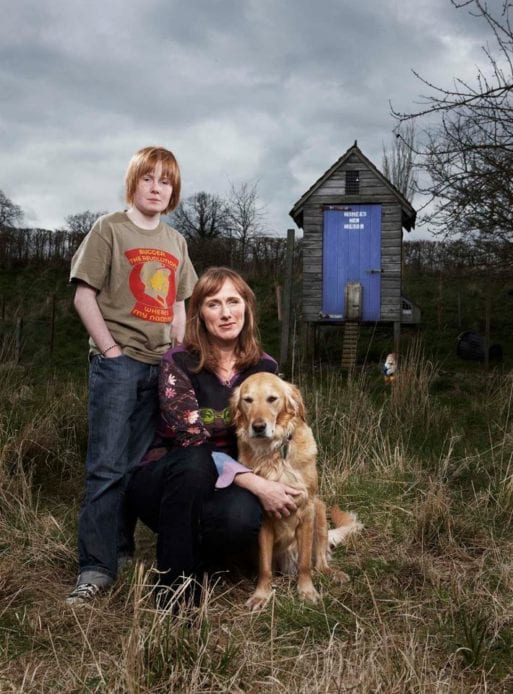 Sacha Langton-Gilks is a bereaved mother. Her son, David, whom everyone called DD, died from a brain tumor in 2012 at the age of 16. He had been ill for five long years, many of them marked by efforts to effect a cure. A singing teacher by profession, Sacha became a writer when she decided to create a book about helping your child die a dignified, comfortable death. She titled the book “Follow the Child.”
Sacha Langton-Gilks is a bereaved mother. Her son, David, whom everyone called DD, died from a brain tumor in 2012 at the age of 16. He had been ill for five long years, many of them marked by efforts to effect a cure. A singing teacher by profession, Sacha became a writer when she decided to create a book about helping your child die a dignified, comfortable death. She titled the book “Follow the Child.”
“Follow the Child” is an amazing book. In part a chronicle of DD’s illness, it is also a primer on palliative care and a how-to manual for parents who are navigating one of the worst nightmares imaginable — watching their child die. Written from the perspective of someone who has “been there,” it is richly detailed and intimate, but at the same time teeming with practical advice. From “The Difficult Conversation” Parts I and II, which cover every imaginable aspect of talking to your child, his medical team, his siblings and friends, to chapters about the last two weeks, the last two days, and the hours after death, it is truly bewildering in scope. Although Sacha admits to spending much of the time preceding DD’s death in a haze of grief and pain, she manages to recount the journey in astonishing detail.
Sacha and her family live in the United Kingdom, so parts of the book are not entirely applicable to parents and children in the United States. In the U.K., for example, people, including children, are eligible for hospice care at the onset of a life-limiting illness. There’s no requirement that a physician attest that they have “x” amount of time to live. The palliative care construct is also far more developed in Great Britain than it is here in the U.S., although Sacha is quick to say it is still woefully inadequate. If a child is dying at home and has a medical emergency, for example, the parents can call an ambulance and receive medical treatment from first responders in their own home (as long as the appropriate documentation has been filled out). In the United States, except in the rarest of circumstances, first responders are required to take the person to a hospital to receive care.

DD endured five years of intensive treatment, including a stem cell transplant. But just 6 months after the procedure, he was back on his surfboard
Credit: Sacha Langton-Gilks via Facebook
In general, though, the guidance in “Follow the Child” is both helpful and relatable. Sacha talks about seemingly impossible subjects such as the benefits of dying in a hospital versus dying at home (there is a surprising array of pros and cons to each); organ and tissue donation; and after-death care. She details how even a young child can create an advance directive (called an advance care plan in the U.K.) using a template created by the pediatric oncology team at the University of California San Francisco called “Voicing My Choices: A Planning Guide for Children and Young Adults.” And she provides some invaluable tips to help overwhelmed parents care for themselves while the journey unfolds.
Heartbreak and Peace
Each part of “Follow the Child” is helpful and instructive. And, as you would expect, much of the book is also terribly sad. In addition to telling us about her own journey, Sacha also shares the stories of several other mothers whose children had incurable illnesses and eventually died. Some of the most touching parts of the book come as these women describe the last moments of their children’s lives.
“So Keir died at 1:10 pm surrounded by all those who loved him so much. We couldn’t save him but we could make his life full and his death calm, and this we did and that made all the difference [and] is without doubt my greatest achievement. He was without doubt the bravest, most amazing person I will ever have the pleasure to know and I’m so proud to call him my son.” -Michele, speaking of her son Keir’s death
The women also share the stories of their children’s funerals. And while these, too, are difficult to read, they are wonderful examples of the many ways bereaved parents can choose to say good-bye and celebrate their children’s lives. Theresa, for example, has this to say
“Are you kidding? We had a party. No funeral. A Celebration of Life. Attendees were instructed not to wear black, only bright colors. Those who knew us really well wore super-hero t-shirts. It was awesome! Nearly 300 people packed the church.

Sacha Langton-Gilks poses with DD and the family dog
Credit: Sacha Langton-Gilks via Facebook
Several parents also share their thoughts about keeping their child’s ashes (from the context, it seems that scattering or burying ashes is considered the norm in the U.K.). Alison keeps her son Ryan’s in a memorial teddy bear with a special pouch. Sacha keeps DD’s ashes in the boy’s old room. She says friends may be worried that the fact that she hasn’t yet scattered them means she hasn’t “moved on.” To this, she responds, “I like to correct that language to ‘moved forward’ as to me moving on implies leaving someone behind, and I like to think DD is still, and always will be, with us moving forward.”
“It’s not a shrine,” she adds. “We like having him around.”
Sacha sums up the message of “Follow the Child” in the final chapter by admonishing parents, “You only have one chance to get it right.” There are no do-overs when a child is dying, so parents and care providers need to work tirelessly together to make sure the child gets the care he needs to have a “good death.” And for parents who wonder how they can possibly cope with this, she adds firmly but lovingly, “You are not alone, and you can do this.”
And at the very end, she shares DD’s favorite quote
Life is suffering, but every second of life is a miracle. ~

 “Follow the Child” by Sacha Langton-Gilks
“Follow the Child” by Sacha Langton-Gilks



 Trans Remembrance Project Provides a Community of Grieving
Trans Remembrance Project Provides a Community of Grieving
 Caring for a Dying Loved One? Be Gentle With Yourself.
Caring for a Dying Loved One? Be Gentle With Yourself.














